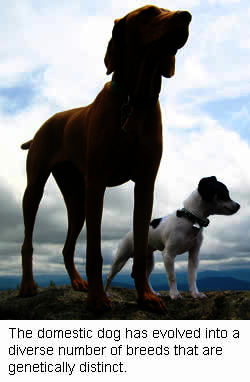Are you surprised that the tiny chihuahua belongs to the same species as the imposing great dane? The domestic dog species (Canis familiaris) includes more than 400 breeds that differ, for example in their appearance (size, coat length, and color) and behavior, (guarding, herding, and hunting).
More than 150 breeds are officially recognized by the American Kennel Club, which assigns each breed to one of seven groups or a miscellaneous class, based on the uses for which the breeds were originally developed.

The modern categories include breeds that have been around for fewer than 400 years:
- Working dogs/guard dogs, e.g., mastiff, bulldog, boxer
- Herding dogs, e.g., Belgian sheepdog, collie, shetland sheepdog
- Hunting dogs, e.g., scent hounds, terriers, spaniels, pointers, retrievers
This genetic classification of breeds grouped dogs together in a way that matched similarities in morphology and geographical origin. However, there were some surprises. For example, the oldest of all dog breeds are commonly believed to be the Pharaoh Hound and Ibizan Hound, which resemble the ancient Egyptian dogs drawn on tomb walls more than 5000 years ago. However, this study failed to detect their ancient lineage. This may be because they are modern recreations of old breeds or because current tools are unable to detect their ancient genes.
In contrast, a diverse group of dog breeds appears to be most related to the dog's ancient ancestor, the grey wolf. These breeds include dogs whose appearances resemble the wolf (e.g., the Siberian Husky) and dogs that do not (e.g., the cuddlely Sharpei). Breeds that belong to this ancient grouping are diverse and originate from different continents, e.g., the Afghan from the Middle East, the Basenji from Africa, the Tibetan Terrier from Tibet, the Pekingese from China, and the Alaskan Malamute from the Arctic.
Parker et al. looked at microsatellites to find the genetic differences between breeds of domestic dogs. Microsatellites are short segments of DNA that contain repeats of DNA sequence. The repeats usually occur in a noncoding part of the gene, and their number is highly variable. Analysis of the microsatellites of 414 dogs representing 85 different breeds revealed that the degree of genetic differentiation between dog breeds is much higher than that found between human populations on different continents!
Given that most modern dog breeds have existed for fewer than 400 years, it is surprising that dog breeds are genetically distinct. But a dog can be matched to its breed by its individual genotype. Of 414 dogs tested, only 4 dogs were assigned to the wrong breed.
This apparent genetic isolation of dog breeds through selective breeding was reinforced by the formation of breed clubs in the mid-19th century. Rules such as the "Breed Barrier Rule" states that "no dog may become a registered member of a breed unless its dam and sire are registered members". Such selective breeding generates not only genetically diverse breeds of dog but also leads to the accumulation of mutations and inherited diseases. By using a genetic classification of dog breeds, scientists will be able to select breeds of dogs that share the same ancient mutations and genetic predisposition to diseases that some humans have. Analysis of this DNA is more likely to yield information about the diseases and the mutations responsible for them.
References
- 1.
- Parker H G, Kim L V, Sutter N B, Carlson S, Lorentzen T D, Malek T B, Johnson G S, DeFrance H B, Ostrander E A, Kruglyak L. Genetic Structure of the Purebred Domestic Dog. Science. 2004;304:1160–1164. [PubMed: 15155949]
Publication Details
Author Information and Affiliations
Authors
Laura Dean, MD.Publication History
Created: October 13, 2004.
Copyright
Publisher
National Center for Biotechnology Information (US), Bethesda (MD)
NLM Citation
Dean L. Who let the dogs out?a genetic classification of dog breeds. 2004 Oct 13. In: Dean L, McEntyre J, editors. Coffee Break: Tutorials for NCBI Tools [Internet]. Bethesda (MD): National Center for Biotechnology Information (US); 1999-.